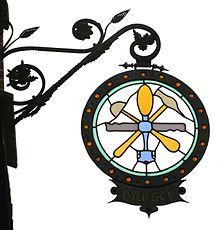Guild

Aguildis anassociationofcraftspeopleormerchantswho control the practice of their craft in a town.[1]
Many groups of people started as guilds, includingscholars,and religious guilds. Many modern organisations, likeuniversities,started as guilds. However, the basic idea of a guild was to control the training and practice of atradeor business. In Europe, guilds were given authority by themonarch.New young members had to serve asapprenticesto a master for a certain length of time (such as seven years). At the end they became full members of the guild, and could set up on their own, and take apprentices of their own. That is the way the European world worked up to and including the first part of the 20th century.
There were guilds ofweaversand dyers in thewooltrade, ofmasonsandarchitectsin thebuildingtrade. There were guilds ofpainters,blacksmiths,bakers,butchers,and so on. TheCorporation of the City of Londonincludes the "livery companies". These companies were originally guilds. The senior members of the livery companies choose theLord Mayor of London,the sheriffs and certain other officers.
Guilds were common in thecitiesof theMiddle Ages.After that, around 1700 to 1800 their influence lessened somewhat.Jean-Jacques RousseauandAdam Smithwere much opposed to the idea of guilds. They believed that guilds hinderedeconomic developmentandfree trade.
References
[change|change source]
